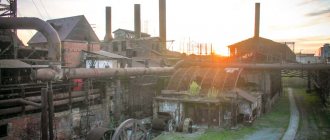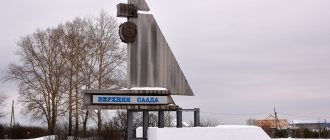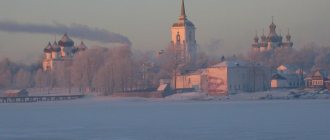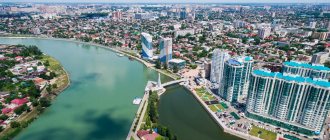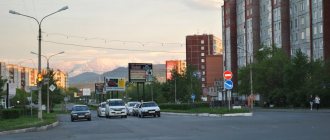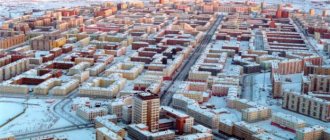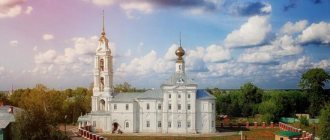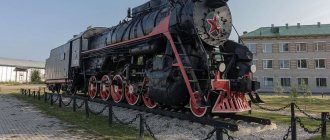What to see
The city is a living monument to the enthusiastic builders who laid the railway.
Most of the city's attractions are, in one way or another, connected with BAM. On the highway between Severobaikalsk and Nizhneangarsk, there is a memorial dedicated to the pioneers - the landing of the tunnelers. The First Tent monument is considered the site of the founding of the city. Nearby, from the observation deck, there is a magnificent view of Lake Baikal and the cape tunnels.
Cape tunnels, cut through the spurs of the Baikal ridge, are an exceptional attraction. These structures are rightly called “the keys to the BAM”. The final choice of the location of the entire highway depended on their successful installation.
The monument is dedicated to the tunnel detachment TO-16 and was erected on the day of the construction of the 3rd tunnel. There are 4 of them in total, with a total length of more than 5 km. All of the detachment’s tunnelers were metro builders, so the letter “M” on the memorial is entirely justified. The heavy equipment that helped people in their work has not been forgotten either.
Yellow MoAZ, a 25-ton underground road train, is installed on a concrete pedestal near the portal of the 2nd tunnel. This machine worked at Mysovye from 1975 to 1982.
In the city itself it will be interesting to visit an art gallery. It opened in 1979, when artists of the USSR donated 500 of their paintings to the new building. Now the museum has more than 2,000 paintings in its collection.
The Museum and Exhibition Complex is located in the same building. The museum is quite small, but extremely atmospheric; the exhibition gives a complete picture of the 40-year history of the construction of BAM. There is an exhibition telling about the life of the Evenks and Buryats, and there are exhibits that give an idea of the nature of the region.
Nearby is the Zheleznodorozhnik Palace of Culture with a huge winter garden - about 100 species of exotic plants. Premiere film screenings, concerts and festivals regularly take place here.
In 2009, the Temple of the Kazan Icon of the Mother of God opened. The church was built at the expense of parishioners.
Onokachanskaya Bay is the visiting card of Northern Baikal. Here is Obo, a place of worship for the Buryats and the first illuminated Suburgan (Stupa) according to Buddhist traditions. The place is considered energetically strong, bringing peace of mind and reconciliation.
Why go to Severobaykalsk?
See the capital of BAM, enjoy the blooming wild rosemary, catch grayling and whitefish on the lake, go on a cave quest, plunge into hot springs, look at seals, try omul, go rafting and freeride.
You can pitch a tent and enjoy maximum freedom at a minimum cost on Yarki Island, or book a room in the posh “Baikal Residence”, where guests are delivered by boat or helicopter. Or you can choose something in between - order a ready-made tour with transfer, bathhouse, excursions and overnight stay in a tent.
Severobaykalsk is the starting point of many tourist routes. Here you can find interesting activities for every taste.
Thermal springs
There are several of them near the city - Dzelinda, Goudzhekit (Solnechny), Kotelnikovsky and Khakusy. These are nitrogen thermal baths, carbonated with nitrogen, methane and hydrogen sulfide. Some of the springs are hyperthermal. The high temperature remains even in the most severe frosts.
The hot spring at Cape Kotelnikovsky is difficult to access and is visited by hiking or horseback tourist groups. This is one of the popular routes leading to the highest point of the Baikal ridge - the city of Charsky.
There is no road. In summer you can get there by water, in winter along the ice of Lake Baikal. A recreation center has been built here, and the indoor swimming pool is open all year round.
In Khakusy Bay there is a balneological resort of the same name. The landscape and microclimate here are exceptionally beautiful. Lots of pines, cedar, juniper, fir. The water of Khakusy is similar in composition to the springs of Pyatigorsk.
Dzelinda is located 92 km from Severobaikalsk in the Upper Angara valley. Water temperature +44○C. The presence of radon gives the spring a special healing effect, and the low content of hydrogen sulfide has a beneficial effect on the general atmosphere.
The Solnechny Spring (Goudzhekit) is an outlet of pressurized thermal waters. The well is very close to the city, 3 km to the west. There is a complex with an outdoor swimming pool.
Before visiting the springs, consult your doctor. Despite the undoubted benefits of thermal baths, there are many medical contraindications.
There are small cottage-type hotels near the springs. During the season, most hiking routes start from here.
The city of Severobaykalsk: history, attractions
The city of Severobaykalsk is the largest of all settlements located on the shores of Lake Baikal. Its history is inextricably linked with the construction of the Baikal-Amur Mainline. The founders of the future city are the first Komsomol members who arrived at the construction site of the century at the call of the Komsomol and the party.
Now few people know about this city. But judging by the reviews of tourists who have been here at least once, some want to return again. And first of all, they are attracted by natural attractions - the lake itself, healing thermal springs, an ancient settlement found on the shores of Lake Baikal.
Read on and get to know the city. Maybe you will also have a desire to take a trip to northern Baikal. You can get to the city by rail, by plane, or by road.
How Severobaikalsk was built
To build a city in the north of Baikal with a population of up to 140 thousand people was in the plans for the construction of BAM. It was also planned to build two large factories in the city. The city was built, but the factories were not. Most likely the reason lies in a lack of funding, or in the environment - close proximity to the lake.
The first detachment of Komsomol members arrived on July 23, 1974 and formed a labor camp at the new location. So, the city of Severobaikalsk began with tents, trailers, and temporary panel buildings. (But at first the pioneers called their village New Year’s. Then the name changed two more times.)
The labor camp grew rapidly. More and more groups of volunteers arrived at the construction site, mostly envoys from Leningrad. In September 1974, the working settlement of Severobaikalsk was formed. The first five-story capital building was built in 1978. Now this house is located at the address: Leningradsky Prospekt, building 4. In honor of this event, a memorial plaque hangs on the wall of the house.
This was the first house of the 122 series, which is now built up in the city center. The project of a house in this series was developed by LenZNIIEP (Lenigrad Zonal Research Institute of Experimental Design) specifically for Severobaikalsk. The project took into account all the difficult construction conditions and, first of all, high seismicity (up to 9 points) and permafrost, when opened, the soil began to thaw.
The houses in this series have a broken façade shape and are built in such a way that they form an open ring, protecting the courtyard from the constantly blowing cold winds from Lake Baikal. But, above all, such houses have increased earthquake resistance.
Construction was further complicated by the fact that there were no land routes for the delivery of building materials, machinery, and equipment. Therefore, the bulk of cargo was transported by water transport along Lake Baikal, and in winter - by truck on the ice. When transporting goods, it was necessary to carefully observe safety precautions so that no pollution would enter the waters of Lake Baikal.
In the regional center, the village of Nizhneangarsk, which is located 25 km from Severobaikalsk, there was already an airport, but it only accepted 12-seater AN-2 passenger aircraft and MI-8 helicopters, which could not transport large cargo. But these helicopters played a huge role in the history of the construction of BAM.
The landing of volunteers in the taiga first of all cleared a place for a helipad, closer to their camp. Helicopters served as ambulances - urgent delivery of small-sized cargo, evacuation of sick and injured people, delivery of food products.
On November 5, 1980, the village of Severobaikalsk was reorganized into the city of Severobaikalsk. The population of the city at that time was 16.1 thousand people. Until 1991, the population grew steadily and amounted to 29.6 thousand people.
After the collapse of the USSR, people began to leave the city. Many returned to their homeland. After all, envoys from almost all the Union republics of the USSR took part in the construction of the BAM. And now (2019) the city’s population is 23.16 thousand people.
Modern Severobaykalsk
Now the city has everything that ensures a comfortable life for citizens - kindergartens and schools, secondary educational institutions, cultural and entertainment centers, museums, shops, banks, cafes and restaurants, a nightclub. Conditions have been created for recreation and tourism.
Work for city residents is provided by large construction companies, railways, tourism businesses, manufacturing enterprises, including small businesses. There are hotels, inns, guest houses, hostels in the city, and a rest room at the station.
No matter how they write about the low standard of living of city residents, the average salary is 44.2 thousand rubles, when in Russia this figure is 7 thousand rubles less. The average salary in Buryatia is lower by almost 17 thousand rubles. and amounts to 27.6 thousand rubles.
How to get to Severobaykalsk?
Severorbaikalsk is a large railway station on the East Siberian Railway. In addition to freight trains, five long-distance trains pass through the station:
Nizhneangarsk Airport is located 25 km from the center of Severobaykplmka and provides regular air connections with Irkutsk and Ulan-Ude. The runway is designed to carry a take-off weight of up to 25 tons. Therefore, the airport accepts small aircraft - An-24, Yak-40, Cessna 208, An-2 and helicopters of all types.
You can also get from Irkutsk to Severobaikalsk by road. The length of the road is 809 km, the average travel time is about 12 hours. A minibus constantly runs along this road from Irkutsk to Severobaikalsk and back.
The city's attractions
The very first thing a city visitor who arrives by train sees is the station building. Its unusual shape with round porthole windows resembles a ship. The station was built by Leningraders according to the design of the architect Vladimir Avksentyuk.
Perhaps not a single tourist will leave without visiting the Museum of the History of the Construction of BAM. Among the museum exhibits there are many photographs and documents that show and describe all stages of the construction of the BAM. The same museum contains archaeological exhibits found in our region. There are even remains of a mammoth and a woolly rhinoceros.
Here, nearby, there is an art gallery in which paintings not only by local artists are exhibited, but also works by other Russian artists donated to the museum. There is also sculpture and graphics.
A separate exhibition is dedicated to the creativity of local peoples. Fur products, fur paintings, and household items made in the traditions of the northern Evenki people are up for sale. (Read the note “EORPK Chilchigir”)
The Zheleznodorozhnik House of Culture is the center of the city’s cultural life. The cultural center has two auditoriums, a winter garden with exotic plants, and several cafes. Almost all public events take place in the cultural center - concerts, festivals, film screenings.
The Church of the Kazan Icon of the Mother of God was recently built on a high place in the city center. Now it is the center of the North Baikal diocese. The temple is young, but the icon has an interesting history dating back almost a century, which happened after the October Revolution of 1917. Read about the temple here.
The city has its own radio, television, and newspaper. In the city center there is a small park, a shopping center and all this is within walking distance from the station. And since the region is located on the territory of the Republic of Buryatia, the Buryat datsan Tuddenshaddubchoilin was built.
Natural attractions
Our region is rich in thermal springs. 25 km from Severobaikalskaya there is a recreation center Goudzhekit with a thermal spring, the water temperature of which approaches 50 degrees. On the territory of the base there are cottage-type guest houses. The Big Bear ski resort is located nearby. And a little further on is the Ursa Minor base.
There are beaches not only on the shores of Lake Baikal. Both tourists and local residents are attracted by the sandy beaches on Bolshoye Slyudyanskoye Lake. The depth here, compared to Lake Baikal, is shallow and the water warms up better.
Near the Slyudyansky Lakes there is a place called Cape Ludar. This is a mountain with steep slopes towards Lake Baikal. It is notable for the fact that on its top there are the ruins of an ancient settlement. Rock paintings have been found on the steep slopes, and there are several caves.
Conclusion
The city of Severobaykalsk deserves to be known. The tourism business in the city is still very poorly developed. This is probably because the service in hotels, inns and recreation centers is not at the required level. This is also negatively affected by the city’s great distance from large regional centers. And how many people know about the resorts of Severobaikalye, about thermal waters that can cure some diseases. But no one remains indifferent, having at least once seen Baikal, the city, the mountains surrounding it, on the tops of which there is snow until June.
These places are especially attractive for lovers of extreme recreation. For example, can you imagine a winter bike ride on the ice of Lake Baikal? Or, the annual Winter Fishing, which attracts fishermen from different cities of Russia and even guests from other countries.
Ski resorts Ursa Major and Ursa Minor
They are located 30 km from Severobaikalsk on the Davan Pass. Trails of varying difficulty levels. The slope is equipped with a lift. The elevation difference is 200 m. There is equipment rental and the possibility of freeride.
The bases accept guests from February to April. Skiing can be combined with relaxation in the thermal baths.
Hotels and camp sites in Severobaykalsk
Pilgrim 4* hotel in Severobaikalsk from 4,700 rubles. per room. Breakfast can be ordered for an additional price, overlooking the lake
Zolotaya Rybka - rooms with views of Lake Baikal, 24-hour reception and free WiFi.
House near Baikal is a hotel with a private bathroom, wifi and a beautiful view.
Hotel "Sputnik" is an inexpensive hotel in Severobaikalsk with comfortable rooms equipped with everything you need. Cost of living from 1360 rub. per day according to the promotion.
Raduga is a hotel rated “Excellent” by booking, it has everything you need, the cost of accommodation starts from 900 rubles. per day
The Baikal Residence is the most expensive hotel, which, if desired, can be purchased entirely (up to 12 people) and enjoy the most luxurious holiday on Lake Baikal of all possible. Booking page for this hotel
View all hotels in Severobaykalsk
Slyudyanskie lakes and Cape Ludar
Located 25 km from the city. The two lakes Big and Small are separated by a narrow strip of land. There are wonderful pebble beaches here. The depth of the lakes is shallow, they warm up well.
There is a hiking route along the serpentine path to the mica adits. The ascent takes about 2 hours. In the 1930s, prisoners of the Boguchansky Gulag mined mica here for the radio industry. At the end of the path, a panoramic view of Lake Baikal and Tonky Cape opens up.
Cape Ludar is one of the most beautiful places on Lake Baikal and a monument to Kurykan culture. At the top of the rocky ledge are the remains of an ancient settlement and a cave with petroglyphs. The site of primitive people in the Great Ludar Cave existed more than 4,000 years ago.
Fans of ancient history will be interested in visiting the village of Baikalskoye, on its territory there are several Neolithic sites. The village has a developed infrastructure and there is a place to stay.
Transport accessibility
It is convenient to get to Severobaikalsk from Irkutsk by rail or road via Bratsk, Ust-Kut, Magistralny, but you can also get there from Ulan-Ude and Bratsk.
Irkutsk - Bratsk (660 km by road), Bratsk - Severobaikalsk (560 km).
Irkutsk - Severobaykalsk: air (1 hour 35 minutes). Travel time by rail: 32-36 hours; during summer navigation, the m/v "Kometa" runs along Baikal twice a week from Nizhneangarsk and Severobaikalsk to the port of Baikal (10-11 hours).
Ulan-Ude - Nizhneangarsk (1025 km). Nizhneangarsk Airport receives flights from Irkutsk and Ulan-Ude six times a week, flight time to Ulan-Ude is 1 hour 25 minutes.
In winter, a winter road is laid across the ice of Lake Baikal from Chivyrkuisky Bay and the village. Ust-Barguzin to Severobaikalsk. Between the village Nizhneangarsk and Severobaikalsk (25 km of asphalt road) - regular bus service.
Source: Volkov, S. On Baikal / Sergey Volkov. – M.: AST: AST Moscow, 2010. – 568 p.
Frolikha Nature Reserve and Lake Frolikha
Lake Frolikha arose as a result of the melting of the last glacier on the planet. The average depth of the reservoir is 80 m. Since its formation, the ecosystem has remained virtually unchanged. This is virgin territory where perception works completely differently. The water here is very clean and completely transparent.
The Frolikha reserve was created to preserve relict flora and fauna. To travel here it is better to take a guide. Hiking with children is not recommended. Mountain taiga is “fun” for adults. There are many wild animals here, including predators.
There are anomalous zones and territories with unusual landscapes, for example, dunes in the northern part of the reserve. The cape and Ayaya Bay are interesting. A secluded place, sheltered from the winds. Here you can see the famous Baikal seals, go fishing or hunt.
Weather in Severobaykalsk
What is the weather in Severobaikalsk right now and the forecast for the next week
In winter, the average air temperature in Severobaikalsk reaches up to – 25 C°, but there can be severe frosts down to – 43 C°, but they usually fall at the beginning of January, as elsewhere on Lake Baikal.
In summer, the average air temperature in Severobaikalsk can reach up to +25 C°
, in July and August sometimes the thermometer rises above
+30 C°.
The warmest place, which is very loved by tourists and local residents, is Yarki Island, where the water can warm up to +25 degrees.
Severobaikalsk is a very sunny place, like Lake Baikal in general; in terms of the number of sunny days it can compete with any southern resort, not only in summer, but all year round.
Yarki Island
The best place for a “wild” beach holiday. 20 km of pure golden sand between Baikal and Angarsky Sor Bay. The width of the beach is about 100 m. Sand dunes alternate with pine trees and dwarf cedar. In summer, the water here is the warmest on Lake Baikal.
The best time for a holiday in Yarka is from July to September. There are wonderful sunrises, unique sunsets, excellent fishing.
For those who prefer active recreation on the water there are many routes. Rafting on the mountain river Tyya. Traveling along rivers and lakes by boat, catamaran, kayak, yacht. Fishing and hunting all year round. There is upland and waterfowl, you can catch omul and grayling.
In the summer you can take an exciting trip on the Comet: to the village of Nizhneangarsk, to the Transbaikal and Barguzinsky Nature Reserves, Chivyrkuisky Bay and Olkhon Island. If desired, in 12 hours you can cross the entire Baikal from north to south along the coastline and go ashore in Irkutsk.
The city has a large selection of hotels, cafes, restaurants and buffets. For every taste and budget. To the question “What time is best to arrive?” it is impossible to give a definite answer. After all, Severobaikalsk is, first of all, unique nature, and, as you know, it never has a bad time.
Literature
- Yuri Kozlov Road and destinies // “Ogonyok”: magazine No. 52 - 1979 p. 12-13
- Pospelov E.M.
Geographical names of the world: Toponymic dictionary: About 5000 units. M.: Russian dictionaries, Astrel Publishing House LLC, AST Publishing House LLC, 2001. p. 376 - Ch.
ed. Gorkin A.P. Geography of Russia: encyclopedic dictionary. M.: Great Russian Encyclopedia, 1998. p. 529 - Ch.
ed. Lappo G.M. Cities of Russia: encyclopedia. M.: Great Russian Encyclopedia, 1994. p. 415
Hot springs in the north of Baikal (Severobaykalsk)
In the western part of Russia, and in general, in the world, people know practically nothing about the Buryat SPA resorts, but in vain, because healing mineral springs are extremely common in Buryatia, there are more than 300 of them in the Tunkinskaya Valley alone.
I still remember the wonderful open-air hot baths at Zmeevaya Bay in Chivyrkuisky Bay. I would like to get there again sometime.
Each source has its own specifics and specialization. Everyone is famous and famous in their own way. And almost all of them are located in hard-to-reach places; it is almost impossible to visit all the springs at once in one trip in the north of Lake Baikal, you have to choose. And some should be booked several months before the intended trip, so that there are definitely enough places for everyone.
Train Station
It is impossible not to mention another iconic architectural landmark of Severobaikalsk. This is the building of the city railway station, located on the Avenue of the 60th Anniversary of the USSR. It is made of concrete, metal and glass and is distinguished by an original architectural design in the form of a wave. By the way, the stylized silhouette of this building adorns the city coat of arms of Severobaikalsk.
City architecture
Perhaps the most interesting attraction of Severobaykalsk can be considered its buildings. The entire city (if you do not take into account the private sector) is, in fact, five small blocks consisting of five-story houses of the same type. With their rather unusual appearance, they impress all guests of the city (see photo below). Especially for those who understand at least a little about the architecture of the Soviet period.
Almost all of these buildings are distinguished by the broken lines of their facades. Some of them are built in the shape of the letter “L”, others - in the form of open rings. The thing is that Severobaikalsk is located in a seismic zone, and similar designs of residential buildings provide increased resistance to earthquakes. Plus, it helps protect courtyards from the powerful winds that blow here most of the year.
Interesting fact: Severobaykalsk was built by architects from St. Petersburg. Thus, the 122nd series of panel houses widespread here was specially developed by specialists from the Leningrad Institute “LenZNIIEP”. In many courtyards of Severobaikalsk, natural vegetation - pine trees - was preserved. Along many streets there are rowan trees planted by the first builders of the city.
Schools 78
- MBOU "Secondary School No. 1" GSB
- UKP MBOU Secondary School No. 1
- MBOU "Gymnasium No. 5" State Security Service
- MBOU "Lyceum No. 6" State Security Service
- MBOU "Secondary School No. 11" State Security Service
- MBOU "Secondary School No. 3" GSB
- MAOU secondary school No. 1
- MAOU secondary school No. 2 with UIOP
- MAOU Linguistic Gymnasium No. 3
- MAOU secondary school No. 4
- MAOU secondary school No. 5
- MAOU secondary school No. 7
- MAOU secondary school No. 8
- MAOU secondary school No. 9
- MAOU secondary school No. 12
- MAOU secondary school No. 13
- MAOU "Gymnasium No. 14"
- MBOU secondary school No. 15
- MAOU secondary school No. 17
- MAOU secondary school No. 18
- MAOU secondary school No. 19
- MAOU secondary school No. 20
- MAOU secondary school No. 21
- MAOU secondary school No. 22
- MAOU secondary school No. 23
- MAOU secondary school No. 24
- MAOU secondary school No. 25
- MAOU secondary school No. 26
- MAOU Lyceum No. 27
- MAOU Buryat Gymnasium No. 29
- MAOU secondary school No. 31
- MAOU secondary school No. 32
- MAOU "Gymnasium No. 33"
- MAOU secondary school No. 35
- MAOU secondary school No. 36
- MAOU secondary school No. 37
- MAOU secondary school No. 38
- MAOU secondary school No. 40
- MAOU secondary school No. 41
- MAOU secondary school No. 42
- MAOU secondary school No. 43
- MAOU secondary school No. 44
- MAOU secondary school No. 46
- MAOU secondary school No. 47
- MAOU secondary school No. 48
- MAOU secondary school No. 49
- MAOU secondary school No. 50
- MBOU secondary school No. 51
- MAOU secondary school No. 52
- MAOU secondary school No. 54
- MAOU secondary school No. 55
- MAOU FMSH No. 56
- MAOU secondary school No. 57
- MAOU secondary school No. 58
- MBOU Russian Gymnasium No. 59
- MAOU secondary school No. 60
- MAOU secondary school No. 63
- MAOU secondary school No. 64
- MAOU secondary school No. 65
- MBOU MGL
- MAOU "Progymnasium No. 108"
- MBOU Test school 120
- MBOU "Test School No. 100"
- GBOU "SKOSHI V type"
- GKOU SKOSHI No. 62 III-IV type"
- GBOU SKOSH No. 3 VIII type
- GKOU SKOSHI I-II type"
- GBOU Lyceum boarding school No. 61
- GBOU "Republican Mariinsky Boarding School"
- GBOU Republican Buryat National Boarding Lyceum No. 1 for gifted children
- State Budgetary Educational Institution Sanatorium Boarding School No. 28
- GBOU "Republican Cadet Boarding School"
- NOU "Boarding School No. 22 of secondary (full) general education
- MBOU Secondary School No. 1
- GAPOU RB "BRHK"
- GBOU "Republican Center for Education and Psychological and Medical Social Assistance"
- GBOU SCOSHI V type (preschool education)
- SKOSHI No. 2 VIII type
Monument to the city builders
Right next to the city station building there is a spectacular obelisk with a monument to the Leningraders who participated in the creation of Severobaikalsk. It is curious that the sculpture depicts a real character - engineer Vladimir Denisenko. It was his team that in November 1975 laid the first symbolic stone in the foundation of the future city on the shores of Lake Baikal.


